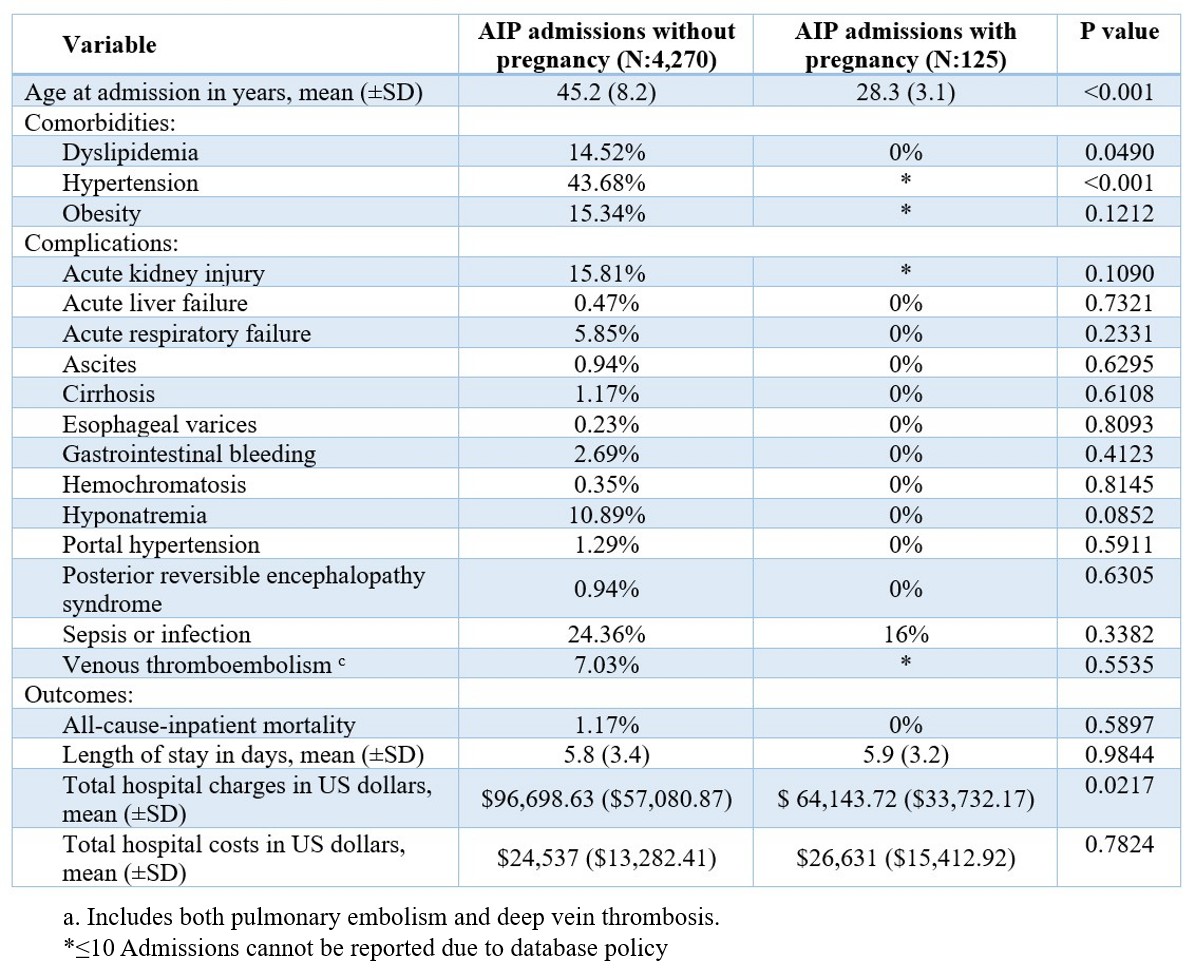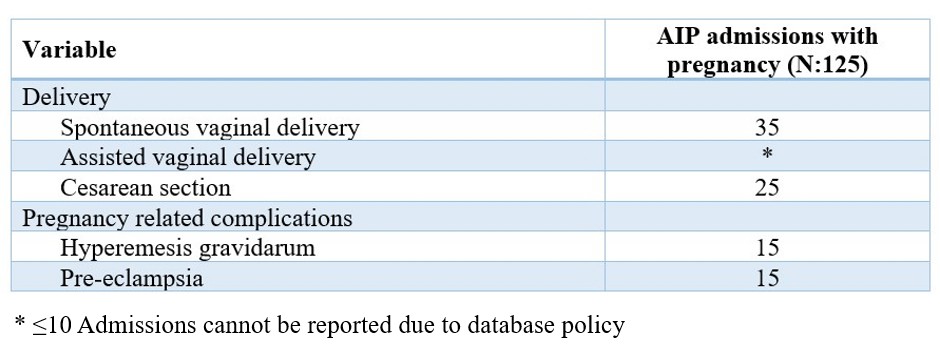Monday Poster Session
Category: Liver
P3791 - Maternal and Clinical Outcomes in Pregnant Women With Acute Intermittent (Hepatic) Porphyria
Monday, October 27, 2025
10:30 AM - 4:00 PM PDT
Location: Exhibit Hall
.jpg)
Aditya Sharma, MD (he/him/his)
Wayne State University School of Medicine / Detroit Medical Center
Detroit, MI
Presenting Author(s)
Aditya Sharma, MD1, Katia El Jurdi, MD2, Aditi Sharma, MD3, Vijendra Singh, MD3
1Wayne State University School of Medicine / Detroit Medical Center, Detroit, MI; 2Henry Ford Providence Hospital, Detroit, MI; 3Karmanos Cancer Institute, Detroit, MI
Introduction: Acute Intermittent Porphyria (AIP) is a rare metabolic disorder characterized by life-threatening neurovisceral attacks, often triggered by hormonal fluctuations such as elevated progesterone levels. While the clinical spectrum and known triggers of AIP are well documented, pregnancy-related variations in comorbidities, healthcare utilization, and outcomes remain poorly understood. We aim to evaluate the impact of pregnancy on hospitalization characteristics and clinical outcomes among patients admitted with AIP.
Methods: We utilized the National Inpatient Sample (2016-2020) to analyze female AIP hospitalizations identified using International Classification of Diseases, Tenth Revision, Clinical Modification codes. Hospitalizations were stratified based on pregnancy status. Comparative analyses were conducted for baseline demographics, comorbidities, complications, and outcomes. Categorical variables were compared using χ² test and reported as percentage while continuous variables are presented as mean ± standard deviation.
Results: We identified 125 hospitalizations of pregnant females with AIP, with a mean age of 28.3 years (60% were White and 16% were Black). Hypertension and obesity were the most common comorbidities. Sepsis/infection was the most frequent complication (16%), followed by acute kidney injury (10%) and venous thromboembolism (8%). No hepatic complications or in-hospital mortality were observed. Pregnant females had significantly higher hospitalization charges compared to non pregnant females ($96,698.63 vs. $64,143.72; P=0.0217). During the hospitalization, delivery occurred in 56% of pregnancies (64.3% were vaginal, with 77% being spontaneous). Preeclampsia and hyperemesis gravidarum were the most common pregnancy-related complications (12% each), followed by postpartum hemorrhage, fetal growth restriction, oligohydramnios/polyhydramnios, gestational hypertension, and medically induced abortion. No cases of preterm labor, intrauterine fetal demise, placental abruption, or spontaneous abortion were reported.
Discussion: Pregnant females with AIP experience notable maternal complications and incur significantly higher hospitalization charges despite the absence of hepatic complications or fetal loss. These findings highlight a critical knowledge gap and underscore the need for larger studies to better understand pregnancy-related outcomes and optimize care in this high-risk population.

Figure: Table: Baseline Characteristics of Females Hospitalized for Acute Intermittent Porphyria With vs. Without Pregnancy in the U.S. (2016–2020)

Figure: Table: Absolute Number of Acute Intermittent Porphyria Admissions with Pregnancy.
Disclosures:
Aditya Sharma indicated no relevant financial relationships.
Katia El Jurdi indicated no relevant financial relationships.
Aditi Sharma indicated no relevant financial relationships.
Vijendra Singh indicated no relevant financial relationships.
Aditya Sharma, MD1, Katia El Jurdi, MD2, Aditi Sharma, MD3, Vijendra Singh, MD3. P3791 - Maternal and Clinical Outcomes in Pregnant Women With Acute Intermittent (Hepatic) Porphyria, ACG 2025 Annual Scientific Meeting Abstracts. Phoenix, AZ: American College of Gastroenterology.
1Wayne State University School of Medicine / Detroit Medical Center, Detroit, MI; 2Henry Ford Providence Hospital, Detroit, MI; 3Karmanos Cancer Institute, Detroit, MI
Introduction: Acute Intermittent Porphyria (AIP) is a rare metabolic disorder characterized by life-threatening neurovisceral attacks, often triggered by hormonal fluctuations such as elevated progesterone levels. While the clinical spectrum and known triggers of AIP are well documented, pregnancy-related variations in comorbidities, healthcare utilization, and outcomes remain poorly understood. We aim to evaluate the impact of pregnancy on hospitalization characteristics and clinical outcomes among patients admitted with AIP.
Methods: We utilized the National Inpatient Sample (2016-2020) to analyze female AIP hospitalizations identified using International Classification of Diseases, Tenth Revision, Clinical Modification codes. Hospitalizations were stratified based on pregnancy status. Comparative analyses were conducted for baseline demographics, comorbidities, complications, and outcomes. Categorical variables were compared using χ² test and reported as percentage while continuous variables are presented as mean ± standard deviation.
Results: We identified 125 hospitalizations of pregnant females with AIP, with a mean age of 28.3 years (60% were White and 16% were Black). Hypertension and obesity were the most common comorbidities. Sepsis/infection was the most frequent complication (16%), followed by acute kidney injury (10%) and venous thromboembolism (8%). No hepatic complications or in-hospital mortality were observed. Pregnant females had significantly higher hospitalization charges compared to non pregnant females ($96,698.63 vs. $64,143.72; P=0.0217). During the hospitalization, delivery occurred in 56% of pregnancies (64.3% were vaginal, with 77% being spontaneous). Preeclampsia and hyperemesis gravidarum were the most common pregnancy-related complications (12% each), followed by postpartum hemorrhage, fetal growth restriction, oligohydramnios/polyhydramnios, gestational hypertension, and medically induced abortion. No cases of preterm labor, intrauterine fetal demise, placental abruption, or spontaneous abortion were reported.
Discussion: Pregnant females with AIP experience notable maternal complications and incur significantly higher hospitalization charges despite the absence of hepatic complications or fetal loss. These findings highlight a critical knowledge gap and underscore the need for larger studies to better understand pregnancy-related outcomes and optimize care in this high-risk population.

Figure: Table: Baseline Characteristics of Females Hospitalized for Acute Intermittent Porphyria With vs. Without Pregnancy in the U.S. (2016–2020)

Figure: Table: Absolute Number of Acute Intermittent Porphyria Admissions with Pregnancy.
Disclosures:
Aditya Sharma indicated no relevant financial relationships.
Katia El Jurdi indicated no relevant financial relationships.
Aditi Sharma indicated no relevant financial relationships.
Vijendra Singh indicated no relevant financial relationships.
Aditya Sharma, MD1, Katia El Jurdi, MD2, Aditi Sharma, MD3, Vijendra Singh, MD3. P3791 - Maternal and Clinical Outcomes in Pregnant Women With Acute Intermittent (Hepatic) Porphyria, ACG 2025 Annual Scientific Meeting Abstracts. Phoenix, AZ: American College of Gastroenterology.

